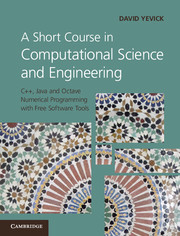 A Short Course in Computational Science and Engineering
A Short Course in Computational Science and Engineering Book contents
- Frontmatter
- Contents
- Chapter 1 Introduction
- Chapter 2 Octave programming
- Chapter 3 Installing and running the Dev-C++ programming environment
- Chapter 4 Introduction to computer and software architecture
- Chapter 5 Fundamental concepts
- Chapter 6 Procedural programming basics
- Chapter 7 An introduction to object-oriented analysis
- Chapter 8 C++ object-oriented programming syntax
- Chapter 9 Arrays and matrices
- Chapter 10 Input and output streams
- Chapter 11 References
- Chapter 12 Pointers and dynamic memory allocation
- Chapter 13 Memory management
- Chapter 14 The static keyword, multiple and virtual inheritance, templates and the STL
- Chapter 15 Creating a Java development environment
- Chapter 16 Basic Java programming constructs
- Chapter 17 Java classes and objects
- Chapter 18 Advanced Java features
- Chapter 19 Introductory numerical analysis
- Chapter 20 Linear algebra
- Chapter 21 Fourier transforms
- Chapter 22 Differential equations
- Chapter 23 Monte Carlo methods
- Chapter 24 Partial differential equations
- Index
Chapter 4 - Introduction to computer and software architecture
Published online by Cambridge University Press: 05 June 2012
- Frontmatter
- Contents
- Chapter 1 Introduction
- Chapter 2 Octave programming
- Chapter 3 Installing and running the Dev-C++ programming environment
- Chapter 4 Introduction to computer and software architecture
- Chapter 5 Fundamental concepts
- Chapter 6 Procedural programming basics
- Chapter 7 An introduction to object-oriented analysis
- Chapter 8 C++ object-oriented programming syntax
- Chapter 9 Arrays and matrices
- Chapter 10 Input and output streams
- Chapter 11 References
- Chapter 12 Pointers and dynamic memory allocation
- Chapter 13 Memory management
- Chapter 14 The static keyword, multiple and virtual inheritance, templates and the STL
- Chapter 15 Creating a Java development environment
- Chapter 16 Basic Java programming constructs
- Chapter 17 Java classes and objects
- Chapter 18 Advanced Java features
- Chapter 19 Introductory numerical analysis
- Chapter 20 Linear algebra
- Chapter 21 Fourier transforms
- Chapter 22 Differential equations
- Chapter 23 Monte Carlo methods
- Chapter 24 Partial differential equations
- Index
Summary
Scientific programming comprises four basic elements: analyzing a physicalproblem, developing a numerical algorithm for solving the problem, designing aprogram that implements this solution within a clear and understandableframework and, finally, determining the accuracy and the limits of validity ofthe numerical solution. Before discussing these, however, we surveycomputational methods and software and hardware architecture.
Computational methods
While most textbook problems possess a high degree of symmetry and/or alimited number of variables and can therefore be solved analytically, real-worldapplications typically require numerical analysis. Further, even analyticsolutions can be unstable, as in water flowing through a cylindrical tube athigh velocity, for which the motion depends critically on the initialconditions. Numerical calculations are then performed for numerous initialconditions and statistical properties derived from the results.
Often a numerical model of a continuous system recasts the solution to the full,global problem as a set of simplified, coupled local problems, each of whichdescribes the system over a restricted spatial or temporal domain. Continuousoperators such as derivatives and integrals are then approximated by employingtheir definition as the limit of discrete differences and sums but withoutpassing to the infinitesimal limit. As an example, the response of a building toan applied force from the ground can be obtained by noting that the forces oneach brick vary only slightly over the surface of the brick. The response ofeach discrete, rigid, brick to these local applied forces can therefore easilybe evaluated. Coupling the forces and displacements on each brick to those onneighboring bricks and to those applied at the boundary between the house andthe ground generates a large system of linear equations that is solvednumerically.
Information
- Type
- Chapter
- Information
- A Short Course in Computational Science and EngineeringC++, Java and Octave Numerical Programming with Free Software Tools, pp. 22 - 25Publisher: Cambridge University PressPrint publication year: 2012